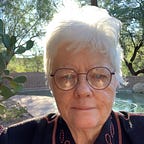Update on 2018 Blog Post by John S. Lewis
Looking back on the blog of space scientist Dr John S. Lewis, well-known for his study of asteroids, I find this article:
Yesterday, 14 November 2018, the discovery of a possible large new impact crater on Earth was publicly announced. The crater, on the northwest coast of Greenland, was revealed by the seasonal retreat of the ice sheet, partially uncovering a circular feature roughly 20 miles in diameter, presently still filled with ice.
The interpretation of the new crater was subject to further investigation, but at this early date, John is quoted as having said the following:
The simplest interpretation of the available data, at this early point in the crater’s exploration, is that it was caused by the impact of a near-Earth asteroid or comet with a diameter of about 2.5 to 3 kilometers. About 1000 Earth-crossing asteroids larger than 1 kilometer in diameter are presently known — and carefully tracked.
So this was 2018. Back thirty years earlier, John and I were sitting with one of his University of Arizona colleagues, Dr. Tom Gehrels. He was even then, in the early days of discovery of Near Earth Objects, concerned with the impact of asteroids and comets on Earth. He made a quite a case for the damage such an impactor could do, and he was right.
It depends on where and when the incoming makes its impacts and how fast it’s coming in, and none of these things were known about this Greenland discovery. But John promised a follow-up as more details were available, and here it is:
First, a second nearby crater was discovered only 100 miles away. An unrelated, older crater, it appears, one nearly twice as old. (Yes, it is wildly improbable that two unrelated comets/asteroids could have impacted Earth within 100 miles, as these appear to have done.)
(One possible explanation: Because of the first discovery, scientists looked nearby for another such impact. And that’s where they found this one. Looking is often a prerequisite for finding.)
And second, even though craters can result from volcanic explosions followed by ice erosion, both these craters have the chemical signature of extraterrestrial material, or in other words debris left from the body that hit Earth, an asteroid or a comet.
What would the consequences be if such an impact occurred in our day? It depends on the size of the impactor, among other details. And it depends on where it hits. More information will be needed as this newer Greenland impactor is investigated. Stay tuned.
Incidentally, about 80% of the impactors of that size fall in the ocean, and often kick up substantial tidal waves. But there’s no signature left behind, and the source of the wave, when it causes havoc somewhere, remains unknown.
To read more about the possible impacts of asteroids and comets on Earth, including the likelihood globally of their causing damage, I recommend John’s book Rain of Iron and Ice, which gives an exhaustive study in layman’s terms of the results of Near-Earth Object impacts on both ancient and modern history, and also our likely future.
John S. Lewis is Professor Emeritus of Planetary Sciences at the University of Arizona, Tucson. He is formerly Professor of Earth and Planetary Sciences at MIT.
Peg Lewis is a novelist, science writer, and world traveler. She likes to write about stimulating locations, such as the Pacific Northwest (the Always Maggie Series about Old Love — Maggie Awake, Maggie Alone, Maggie At Last, and Becoming Ernest) and the Desert Southwest (the Songdog series, in preparation). She also co-authors books (fiction and non-fiction) on space with her husband, well-known space scientist Dr. John S. Lewis.
